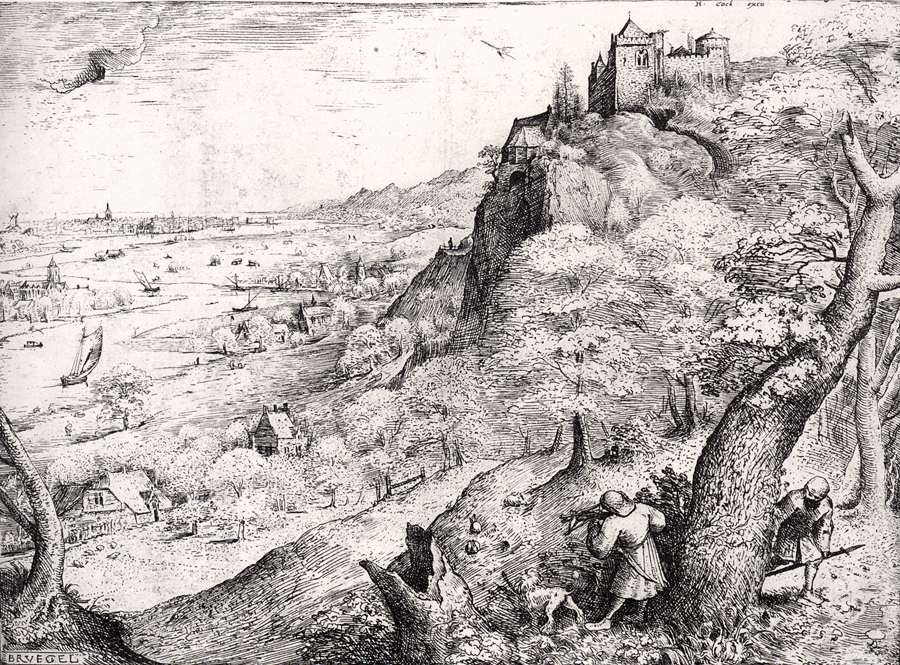.
![http://upload.wikimedia.org/wikipedia/commons/f/f7/Wassen_Gotthardpost_1845.jpg]()
...........................Way
![]()
![]()
The Hare Hunt: Pieter Bruegel the Elder,1560, etching and engraving, 223 x 291 mm (Rijksmuseum, Amsterdam)
![]()
Solicitudo Rustica (Country Concerns): Pieter Bruegel the Elder, 1552-54, pen and brown ink over black chalk, 244 x 352 mm (British Museum, London)
![]()
Solicitudo Rustica (Country Concerns) (detail): Pieter Bruegel the Elder, 1552-54, pen and brown ink over black chalk, 244 x 352 mm (British Museum, London)

Gotthardpostat Wassen: aquatintby Weberafterdrawing byStraub, 1845; image by Adrian Michel, July 2007, from Artur Wyss-Niederer: Sankt Gotthard
...........................Way
For......................Shad
And hills, under sun, where
The path leads
To the church,
.......................Rain
And trees, drowsing
Beneath the heavy tread of the sun,
For even so, even as it burns higher,
Over the steaming cities
Hang curtains of rain
For like ivy it dangles
Down without branches. Beautiful but
Now the ways yield
Fresher blossoms
To the wanderer
.....all outdoors sways.....as a field of grain.
Toward wooded Avignon over the Gotthard
Toils the steed. Laurels
Whisper above Vergil, so that
The sun does not
Unmanfully search out his grave.
Moss roses
Wax upon the Alps. Flowers start up
At the city gates, on the level untended paths
Like crystal growth in fallow wastes of the sea floor.
Gardens bloom round Windsor. On high
Arrives from London
The carriage of the King. Lovely gardens
Relieve the season.
By the canal. Deep below however lies
The even sea, glowing.
Friedrich Hölderlin (1770-1843): Griechenland (Greece), Hymnal Draft, first version, 1803, translation by TCSchifflände Flüelen: colored aquatint by Hürlimann after a drawing by Gabriel Lory, 1820: image by Adrian Michel, June 2007, from Artur Wyss-Niederer: Sankt-Gotthard
Wege des Wanderers!
Denn Schatten der Bäume
Und Hügel, sonnig, wo
Der Weg geht
Zur Kirche,
Reegen, wie Pfeilenregen
Und Bäume stehen, schlummernd, doch
Eintreffen Schritte der Sonne,
Denn eben so, wie sie heißer
Brennt über der Städte Dampf
So gehet über des Reegens
Behangene Mauren die Sonne
Wie Epheu nemlich hänget
Astlos der Reegen herunter. Schöner aber
Blühn Reisenden die Wege
im Freien wechselt wie Korn.
Avignon waldig über den Gotthardt
Tastet das Roß, Lorbeern
Rauschen um Virgilius und daß
Die Sonne nicht
Unmänlich suchet, das Grab. Moosrosen
Wachsen
Auf den Alpen. Blumen fangen
Vor Thoren der Stadt an, auf geebneten Wegen unbegünstiget
Gleich Krystallen in der Wüste wachsend des Meers.
Gärten wachsen um Windsor. Hoch
Ziehet, aus London,
Der Wagen des Königs.
Schöne Gärten sparen die Jahrzeit.
Am Canal. Tief aber liegt
Das ebene Weltmeer, glühend.
Friedrich Hölderlin: Hymnische Entwürfe: Griechenland, Erste Fassung, 1803

Landscape of the Alps: Pieter Bruegel the Elder, c. 1552-1554, pen and sepia ink (Musée du Louvre, Paris)
The Hölderlinian correspondences, those sudden connections between ancient and modern scenes and figures, stand in the most profound relationship to the paratactic method. Beissner too noted Hölderlin's tendency to mix eras together, to connect things that are remote and unconnected; the principle of such associations, which is the opposite of the discursive principle, is reminiscent of the serial ordering of grammatical parts. Poetry wrested both from the zone of madness, where the flight of ideas thrives, as does the readiness of many schizophrenics to see anything real as a sign of something hidden, to encumber it with meaning.
-- Theodor Adorno: Parataxis: On Hölderlin's Late Poetry, a talk given at the annual conference of the Hölderlin-Gesellschaft, Berlin, 7 June 1963; revised version first published in Die Neue Rundschau, 1964; translated by Shierry Weber Nicholsen in Theodor Adorno: Notes to Literature, Volume Two, 1992

The Hare Hunt: Pieter Bruegel the Elder,1560, etching and engraving, 223 x 291 mm (Rijksmuseum, Amsterdam)

Solicitudo Rustica (Country Concerns): Pieter Bruegel the Elder, 1552-54, pen and brown ink over black chalk, 244 x 352 mm (British Museum, London)

Solicitudo Rustica (Country Concerns) (detail): Pieter Bruegel the Elder, 1552-54, pen and brown ink over black chalk, 244 x 352 mm (British Museum, London)
